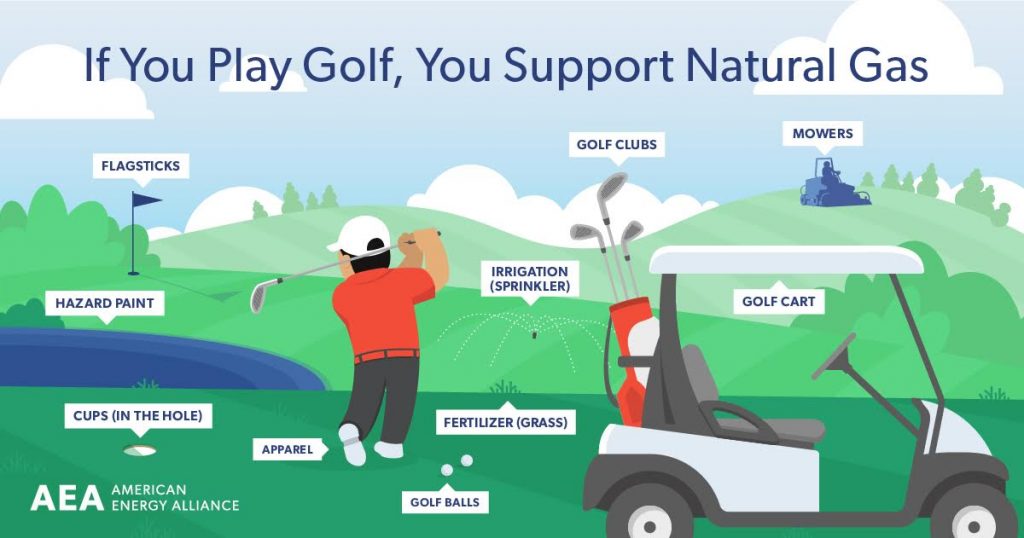Love the game of golf? Thank oil and natural gas
Access to low-cost energy and materials has always been an important part of driving economic dynamism. Given the role that oil and natural gas play supplying our energy, people often underestimate how important oil and gas are to other things they enjoy in life, like the use of plastics. At a time when it is convenient for politicians to deride the industries that provide people access to these essential resources, it’s important to remind people just how important oil and gas are to our everyday lives.
Today, one of the best examples of economic dynamism can be found in perhaps an unlikely place: the game of golf. Over the past two decades, improvements to equipment technology have helped the best (and worst) players hit the ball farther and straighter than ever before. Additionally, in part thanks to improvements in athletic gear, the game has seen the emergence of exciting new players that bring a new class of athleticism to the game. In fact, everywhere you look, from the clothing to the technology that is deployed to maintain golf courses, there is a tremendous amount of innovation in the game of golf. It should come as no surprise then that the oil and gas industries have played a key role driving much of this innovation. From the tee to the green golf courses have been designed and maintained with advanced technologies that make use of these resources. Here, we’ve outlined some of the ways oil and gas are deployed to make the game of golf possible.

Apparel
One of the most striking changes in golf over the past few decades can be seen in apparel. The modern player isn’t forced to struggle through the summer heat in clothing made of heavy cotton. Instead, modern golf apparel makes use of synthetic technologies like polyester, which is a product that is made using petroleum and natural gas. These synthetic materials are lighter and more flexible, helping players to perform at their best in warm climates. Additionally, synthetic fibers have been used to produce better waterproof materials. These products are helpful for playing in the elements during the Open Championship, where it’s the norm to play rain or shine and high winds are an everyday occurrence. Most recently, golf apparel manufacturers have been designing sun protective clothing, which provide protection from UV radiation.
Equipment
One of the biggest stories in golf over the past two decades has been the rapid innovation in golf equipment. In fact, golf club technology has advanced so quickly that there are legitimate debates over whether or not all the new technology is making the game too easy. As is the case with golfing apparel, oil and gas have played a role in driving all of this innovation. Today, golf clubs are manufactured using a wide variety of materials including metals and plastics, all of which make use of oil and gas in their production processes. Plastics are produced primarily from natural gas and crude oil refining feedstocks, and these plastic products are used to help bind the separate parts of the club together. Club heads are milled to perfection using heat and materials supplied from petroleum and natural gas. They are then bonded to the shaft using epoxies that are also derived from petroleum. Club shafts employ a large array of materials, with the most advanced products making use of advanced plastics and graphite, which is the crystalline form of carbon. In addition to the clubs, both gas and electric golf carts derive their energy from oil and gas and many of the parts of these vehicles are constructed using plastic. Finally, golf balls are made using several different types of plastic, with the outer layer usually made up of a thermoplastic and the core designed using a petroleum-based polymer called polybutadiene. All of these technologies have helped to make the easier, allowing more people to enjoy the game. At the highest levels of competition, new equipment technology helps players to shape shots more easily, and allows the best players to routinely hit 300-yard drives.
Golf course
Nearly every part of the golf course and all of the equipment needed to maintain it rely on products that are made from oil and gas. Irrigation pumps, sprinkler heads, and piping are generally all made from plastics. The fertilizers used to keep the course in top condition and the pesticides used to protect players from insects are all made using oil and gas products. The flagsticks, cups, and hazard paints are all made using plastics or other substances derived from oil and natural gas. Finally, the lawn mowers and gardening equipment that are used to maintain the best conditions all run on oil and gas.
Conclusion
Golf began in the year 1457; since then millions have adopted the game and nearly 34,000 golf courses have been developed across the world. In the modern era, oil and gas have played a role in developing the game we all enjoy today. If we think about the role of oil and gas in providing lower transportation costs, allowing people more access to the game in remote parts of the world, it’s easy to see that golf wouldn’t be the game it is today without these industries. So next time you tee it up, take a moment to appreciate the role the oil and gas industry have played in making your round of golf possible.

Speak Your Mind